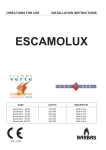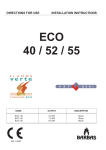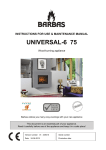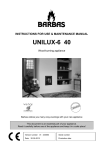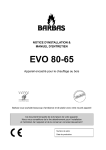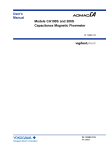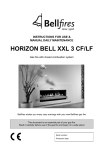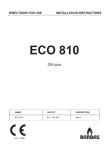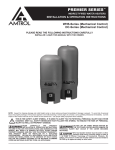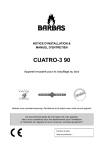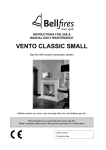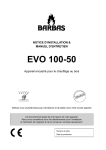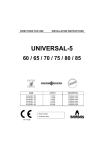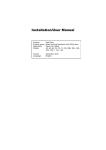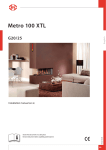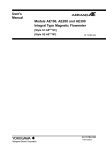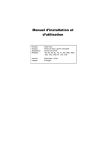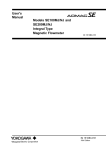Download User manual - Interfocos
Transcript
DIRECTIONS FOR USE INSTALLATION INSTRUCTIONS ENERGA 70-55 Tunnel NAME OUTPUT DESCRIPTION Energa 70-55 Tunnel 23.0 kW Fireplace insert EN -13229 ENERGA 70-55 TUNNEL ENERGA 70-55 TUNNEL 3 ENERGA 70-55 TUNNEL 4 ENERGA 70-55 TUNNEL BARBAS ENERGA WOOD-BURNING BUILT-IN FIRE WITH THE FOLLOWING CHARACTERISTICS: - High efficiency Energy saving Low flue gas emissions Fitted with a ceramic particulate filter (Patent pending) Very low particulate exhaust Environmentally friendly 5 ENERGA 70-55 TUNNEL 6 ENERGA 70-55 TUNNEL INTERFOCOS B.V. 11 EN 13229:2011 Built-in wood fire fired by solid fuels for space heating in residential buildings. - Name: Barbas - Model: ENERGA 70-55 Tunnel - Types of fuel: Wood logs and briquettes (= pressed wood blocks without binding agent) Fire safety: (risk to adjacent elements/objects) - Thickness of insulation material Pass - Rear - Side - Top - Bottom ≥ 100 mm ≥ 100 mm ≥ 100 mm ≥ 30 mm Insulation material: Mineral wool or sheets as shown in table in Chapter 2.6. Temperature resistant ≥ 700°C - Indicated safety distances to flammable material - Front - Other sides ≥ 1500 mm See Chapter 4 Emission combustion products + Pass + carbon monoxide (CO) emission: 0.10% Escape of hazardous substances Not determined Surface temperature Pass Electrical safety Pass Cleanability Pass Flue gas temperature 313°C Mechanical resistance Pass Capacity (= nominal heat output) and energy efficiency, such as: - efficiency Pass (79%) - flue draught 12 Pa - interval replenishing wood at: - nominal heating capacity (= nominal heat output) 0.75 h - space heating capacity (= nominal heat output) 23.0 kW Durability Pass 7 ENERGA 70-55 TUNNEL 8 ENERGA 70-55 TUNNEL TABLE OF CONTENTS Page 1. 2. 3. 4. 5. 6. 7. 8. 9. 10. 11. 12. 13. 14. 15. Introduction 1.1 Foreword....................................................................................... 1.2 Safety and installation instructions................................................ Placing 2.1 Included........................................................................................ 2.2 Preparation for positioning............................................................ 2.3 Accessories................................................................................... 2.4 Basic requirements for positioning built-in fires............................. 2.5 Construction requirements............................................................ 2.6 Heat-insulating materials............................................................... 2.7 Chimney......................................................................................... Installation instructions 3.1 Requirements relating to the use of existing chimneys................. Fitting the fireplace 4.1 Preparation / inspection of function............................................... Operation of the fireplace....................................................................... Stoking up for the first time..................................................................... Use 7.1 Ventilation...................................................................................... 7.2 Getting the fire going..................................................................... 7.3 Instructions while stoking............................................................... 7.4 Heating economically..................................................................... 7.5 Cleaning the window...................................................................... 7.6 Removing and returning the holder with the particulate filter........ 7.7 Replacing the particulate filter....................................................... 7.8 Adjusting the flue gas flap............................................................. General hints 8.1 Tips................................................................................................ 8.2 Output............................................................................................ Fuel........................................................................................................ Amount of fuel 10.1 Amount of fuel................................................................................ 10.2 Heat radiation................................................................................ Regular maintenance.............................................................................. Replacement parts................................................................................. Dimensions............................................................................................. Technical data......................................................................................... Frequently asked questions.................................................................... 11 11 13 13 18 18 22 22 24 25 27 35 36 37 37 38 40 40 41 43 44 46 47 48 49 50 51 52 53 56 58 9 ENERGA 70-55 TUNNEL 10 ENERGA 70-55 TUNNEL 1 INTRODUCTION 1.1 FOREWORD We would like to congratulate you on your purchase of this modern Barbas built-in wood fire. This quality product will give you years of heating pleasure as you enjoy the play of the flames and the cosy glow of the fire. The appliance is fitted with a ceramic particulate filter that ensures low emission values for the flue gases and a very low particulate emission. This manual contains directions for both positioning the appliance and for its environmentally-friendly use. It also contains technical data for the appliance, parts information and directions in the event of problems. Study this manual carefully before using the stove. We recommend you keep this manual in a safe place for reference purposes. 1.2 SAFETY AND INSTALLATION INSTRUCTIONS Safety • Do not place flammable objects within 150 cm of the appliance. Pay special attention to furnishings and ornaments around the fire. • When you use your fire, the exterior will become hot. Always wear the glove or use the accessories supplied when filling etc. Protect yourself and others (especially children!) from burns. Do not leave children unattended when the fire is burning. • Watch your clothing. Synthetic clothing in particular can easily catch fire and burn intensely. • Do not approach the appliance with flammable materials or liquids. Any work with solvents, adhesives etc. in the space heated by the fire can be very dangerous. • Make sure you know what state your chimney is in. Cracks in the chimney may not only lead to damp, staining of walls and leaking of smoke, they can also impair the carrying off of smoke. Make sure you get proper advice from your Barbas dealer or other specialist company. • Avoid chimney fires! Have your chimney swept at least once per year - more often if you use your fire a lot. Prevent excessive deposits of soot inside the chimney by not burning freshly-cut wood. Instead, burn clean, dry chopped wood. • Do not use your built-in fire as a barbecue. This can cause (flammable) fat deposits to be left in the chimney and hastens the chimney becoming clogged. Prevent your chimney being soiled from above (birds’ nests etc.) by fitting a suitable cap to the chimney pot. 11 ENERGA 70-55 TUNNEL • Follow the instructions issued by your local fire brigade. The fire can be taken in operation if national and local regulations are satisfied. The required constructive adaptations should be satisfied as well. Installation Instructions • Wood and wood briquettes may be stoked in the fire. Coals can’t be burned in the fire. • Never use the appliance to burn rubbish. • Please read all instructions/stickers on and around the appliance. • Please also study the directions for use before using the appliance for the first time. When you first fire up your appliance, there are a number of extra points you should take into account. See chapter 6. • In transit, some parts of the appliance may have moved from their original place. Check that the door opens and closes, the particulate filter and retardant plate (brake plate) are fitted correctly to the brackets at the top of the fire, the side-panels are fixed to the walls and the bottom plates have not moved. Check whether the grate is lying correctly and there are no foreign objects in the ashtray. • Avoid over-loading (white burning glow), caused, for example, by lengthy burning with a fully open primary air vent (combustion air supply slider all the way to “ + ”), or by burning too much wood in one go. The fire can then become over-heated. The grate, particulate filter and the metal flue gas flap could then be damaged. • The appliance may only be set up if the appliance and location meets the - national and local installation regulations; - local fire brigade regulations and required architectural provisions. 12 ENERGA 70-55 TUNNEL 2 LOCATION 2.1 INCLUDED Documentation Warranty Manual Attributes Glove (Heat resistant up to max. 95°C) Operating hook / Poker Carrying brackets (2x) N.B. If any part is missing, please contact your dealer. 2.2 PREPARATION FOR POSITIONING Check all functions of the built-in fire before fitting. • Check the opening and closing operation of the door. Turn the handle all the way down: Door is locked. • Handle forwards: The door releases from its lock and can be opened forwards. For this, use the operating hook supplied. 13 ENERGA 70-55 TUNNEL • Check the operation and setting of the flue gas flap and the particulate filter. Locking slider (inside door) Pin for flue gas flap Combustion air-supply slider Locking slider all the way to the left (closed): Flue gas flap operation works normally: Door open Pin comes forwards Flue gas flap open Door closed Pin is pressed in by the door Flue gas flap closed Locking slider all the way to the right (open): Flue gas flap always remains open !! • 14 Flue gas flap in “open” position. ENERGA 70-55 TUNNEL • Check whether the retardant plate (brake plate) is located correctly in the supports. See Chapter 7.6. • Check the operation of the slider for the regulation of the combustion air intake (middle below the window). • Check whether the ashtray is completely empty. 15 ENERGA 70-55 TUNNEL • Report any defects immediately to your dealer. • Remove enclosed documents and components from the built-in fire. • Open the connection openings for the convection air outlet and the convection air supply. • Important: • Connection convection air outlet - top side of the appliance. Using a hammer, open minimal two convection air outlet openings on the top of the fire !! In this way, the discharge of the heat that accumulates in the convection casing is guaranteed. Energa 70-55 Tunnel (Open the openings diagonally.) 16 ENERGA 70-55 TUNNEL • Connecting convection air intake - at the side of the appliance. ° Using a hammer, open at least one of the two convection air intake openings on the side of the appliance !! • Ventilation casing / fireplace. Ensure that the casing/fireplace has sufficient ventilation openings (See Chapter 2.4; The casing/fireplace and Chapter 4.1). 17 ENERGA 70-55 TUNNEL 2.3 ACCESSORIES The following accessories can be supplied by your dealer: Part no Accessorie 330171 3-Sided 35 mm frame Energa 70-55 / Energa 70-55 Tunnel 330172 4-Sided 35 mm frame Energa 70-55 / Energa 70-55 Tunnel 312829 302188 310178 309872 309730 304040 Convection set General: (for convection air extraction) • • • • • 1x Flexible aluminium pipe Ø125 mm, L= 3 m (max.) 2x Fitting box 135 x 135 mm 2x Convection exit grid, white, 145 x 145 mm 2x Collar adaptor Ø125 mm 4x Hose clamp Ø125 mm 2.4 BASIC REQUIREMENTS FOR POSITIONING BUILT-IN FIRES General The appliance may only be set up in a room in which the location, architectural construction and activity is not endangered by the presence of a fire. The surface on which the appliance is to be placed must be correctly shaped and big enough to accommodate the appliance safely (in compliance with DIN 18895, part 1). When fitting, all local and/or national safety regulations must be followed closely, particularly in rooms with walls/floors containing flammable material. If in doubt, consult the fire prevention department of your local fire brigade and/or the architectural department of your local authority. Built-in fires may solely be used in: • Rooms with at least one outer door or window that can be opened; • A suite of rooms connected directly or indirectly with each other with a collective supply of air. In the aforementioned cases, the capacity of the room(s) must be at least 4 m³ per kW of nominal output. Built-in fires may only be constructed or moved into rooms where at least 360 m3 combustion air per hour and per m2 clear fire opening can circulate. If there are any other fire-burning appliances in the same room, at least 540 m³ combustion air per hour and per m² clear fire opening must be in circulation. Other appliances must have at least 1.6 m³ combustion air per hour, per total nominal output in kW at a calculated pressure difference of 0.04 mbar with the ambient air. 18 ENERGA 70-55 TUNNEL Built-in fires must not be used in: • Staircases, except in buildings with no more than two apartments. • Entrances providing general access. • Rooms in which highly inflammable or explosive substances are processed or manufactured. • Garages; • Rooms or apartments with air conditioning or convection heating provided by fans, unless it can be guaranteed that they will not interfere with the working of the fire. This is under the following conditions: ° the installation merely circulates air around the room; ° the installation has sufficient safety provisions preventing the possibility of spontaneous and automatic underpressure being created in the room in which the fire is situated; ° that the combustion air stream created by the fire and the volume streams of the extraction installations in the room and adjoining rooms connected by de-aeration connections do not create underpressure greater than 0.04 mbar. This must also be guaranteed if easily accessible air-conditioning equipment is moved or removed from the room. Provision of combustion and convection air The local chimney sweep/authorities must be consulted prior to fitting regarding the suitability and combustion air supply. DIN 18160 must be observed. DIN 18895 parts 1 and 3 also apply. The air, which is piped in through a grill in the wall, ensures that the air in the room is refreshed and is also used for the combustion process. The combustion air is sucked in through the grill in the chimney breast and through the opening underneath, or at the side of the appliance. Because some of this air passes through the chimney breast, it can be referred to as pre-heated combustion air. The built-in appliance can also be fitted with an air duct which draws the combustion air directly from outside. The air intake must have a opening of at least Ø125 mm. If required, the air pipe can be fitted with a control damper. In this case, the position of the damper must be visible from the outside. The use of a direct combustion air intake is strongly advised if the appliance is fitted with a convection set. 19 ENERGA 70-55 TUNNEL The casing / fireplace • The casing may not be directly connected to the built-in fire, but must be constructed so that it is self-supporting; a mantle iron or lintel should be used for this. The covering in the area must be of non-flammable materials of flame-retardant material class A1. This includes bricks, cladding, ceramic tiles, metal or plasterwork, Promatec and Nobranda. • The opening for incoming and outgoing air from the casing must be at least totally 900 cm². At least 200 cm² from the opening for incoming and outgoing air must not be closable. • The ventilation of the casing/fireplace can be provided by grills, but this can also be achieved by not building the fireplace right up to the ceiling (leaving a gap of 5 cm). 20 ENERGA 70-55 TUNNEL Figure 1: Use of convection set. Ventilation and combustion air intake via the chimney breast. • When building in the appliance you can, if you wish, use a convection set (option) to connect the convection openings to the warm air exit grills in the chimney breast (See figure 1 and Chapter 4). 21 ENERGA 70-55 TUNNEL • Connecting convection set (option) to the convection air escape openings on the top of the appliance: ° Place the collar rings (2x or 4x) on the convection openings. ° The convection air pipes must be made of non-flammable material which cannot be distorted. ° Attach the flexible hose to the collar ring. • Within a range of 30 cm either side and 50 cm above the escape openings in the chimney, there must be no flammable materials (e.g. wooden ceiling, fitted furniture). • The convection casing of the built-in fire must be covered all around with a 10-cm thick layer of insulation (use of ceramic wool is permitted). 2.5 CONSTRUCTION REQUIREMENTS Built-in fires must be constructed such that the adapter from the chimney and convection pipes can easily be cleaned. There must be no electrical cables or gas pipes in the walls surrounding the area of the fireplace. In accordance with construction regulations (in Germany), combustion air pipes in buildings with more than two inhabited floors containing piping and cabling running through fire walls must be fitted in such a way that fire and smoke cannot escape to other floors or rooms. 2.6 HEAT-INSULATING MATERIALS The heat-insulating materials to be used must meet specific quality standards. Manufacturers of insulating materials quote an insulation number on the packaging consisting of 10 numbers in accordance with the stipulations of AGI-Q132. Only those insulating materials listed in the adjacent table 1 or alternatives approved (in Germany) by DIBT may be used. 22 ENERGA 70-55 TUNNEL Insulation material Delivered in ... Heat conductivity Can be delivered as Max user temperature Density Code ºC Code kg/m³ Mats (1) 20 200 02 20 Mats (2) 25 250 03 30 Granular fibres 30 300 04 40 04 Felt 35 350 05 50 05 Fins mats 40 400 06 60 06 Mats 45 450 07 70 07 Plates 50 500 08 80 08 Bowls 55 550 09 90 09 Segments 60 600 10 100 10 Twisted Code Code Sort Code 10 Mineral fibre 01 Strips 01 11 Glass fibre 02 Individual fibres 02 12 Stone fibre 03 13 Cinter fibre 99 Form Other 10 Bowls (1) 65 650 11 110 11 Bowls (2) 70 700 12 120 75 750 13 130 80 800 14 140 85 850 15 150 90 900 16 160 17 170 18 180 19 190 20 200 99 Different approval standard 20 Plates (1) 21 Plates (2) 99 Tailor made 99 Different approval standard * Table 1: data on heat-insulating materials (permitted heat-insulating materials are those in grey). Summary of insulation properties: • • • • Temperature resistance > 700°C Density > 80 kg/m3 Insulation figure as per AGI-Q 132 Must not end with 99 (see table) 23 ENERGA 70-55 TUNNEL 2.7 CHIMNEY Every fire needs its own chimney. Multiple connections to one main chimney is not permitted. Ensure that any existing chimney is completely air-tight and in good condition. It must be suitable to accommodate the appliance in question. Make sure your chimney has a proper cap to prevent rain getting in and birds nesting on it. The draught in your chimney determines how your fire will burn. The recommended draught is approx. 15 Pa (0.15 mbar). Your chimney should be at least 4 metres tall from the point at which the chimney connects to the fire. Chimneys which are wellinsulated measuring in excess of 8 metres can develop a significant draught if the fire is raging. We therefore advise you to fit a chimney damper or draught diverter between the fire and the chimney. 2.7.1 Chimneys Ensure that any existing chimney is completely air-tight and in good condition. The diameter of the entire chimney, including the chimney pot on the roof must have a diameter at least equal to the diameter of the flue gas outlet of the appliance. See chapter 14. If there is no suitable chimney immediately available, we advise you to use doublewalled insulated stainless steel pipe sections. A chimney must be compliant with the prevailing building regulations. Have a specialist carry out the building. When purchasing such pipe sections, we advise you to find out whether some form of casing of the pipes is required. A few points for your attention: • chimneys must be free-standing, i.e. they must not rest on the appliance itself. • all connections between the appliance and the chimney must be properly insulated. • flammable material must be kept clear (outside the casing/insulation zone) of all through-feeds in the floor or wall (remember the roof decking). Do not make any horizontal connections. Deposits and soot will collect here (unless it is a short horizontal connection directly behind the built-in fire). The chimney calculation, as in Germany, is made according to DIN 4705 parts 1 and 2 with each of the following measured values. See chapter 14. - mass flow of the flue gasses; - temperature of flue gases (at flue gas connection to the appliance) - chimney draught (nominal heat output) 24 ENERGA 70-55 TUNNEL 3 INSTALLATION INSTRUCTIONS 3.1 REQUIREMENTS RELATING TO THE USE OF EXISTING CHIMNEYS The adapter material for the connection with the chimney must be made of at least 2 mm thick sheet steel and must be insulated with a heat-resistant material 3 cm in thickness. Connect the pipes to the existing chimney using a sliding sleeve in the ceiling (niche pipe). Check all connections for air-tightness. If the smoke outlet leads through parts containing flammable material, such as walls, the adapter must be encased in at least 20 cm of a mineral substance (such as aerated concrete). Protection of the basic surface (surface) When fitting a built-in fire on a surface containing flammable material, the surface must be fitted with a covering layer of a non-flammable material such as concrete with a thickness of 6 cm. The concrete plate must be of sufficient dimensions to act as a bearing surface. The concrete plate must then be covered with at least 3 cm of heat insulation. If a concrete pedestal is not immediately available, a pedestal should be built on the creeping space. Parquet or wooden flooring must not extend to within the chimney breast. Protection of the floor, in front of the built-in fire/fireplace The floor, in front of the built-in fire/fireplace must be made of non-flammable material. The minimum dimensions of these non-flammable surfaces must be as follows. • At the front, the dimensions are determined by the height of the heating area measured from the bottom plate (h) plus 30 cm (h+30 cm), however no less than 50 cm. • At the sides, the dimensions are determined by the height of the heating area measured from the bottom plate (h) plus 20 cm (h+20 cm), however no less than 30 cm. Construction parts containing flammable substances or material and fitted furniture within the radiation area of the fitted fireplace Any flammable materials should be kept outside an imaginary circle with an 150 cm radius centred on the built-in fire. Ceiling above the built-in fire/fireplace If the hollow space above the fire reaches as high as the ceiling, it must be protected if it contains any flammable material and/or if it is a bearing structure. Such protection should be in the form of a 10-cm thick heat-insulating layer. 25 ENERGA 70-55 TUNNEL Construction parts containing flammable substances or material and fitted furniture outside the radiation area of the fitted fireplace There must be a distance of at least 5 cm between the outside surfaces of the chimney breast/casing/fireplace into which the fire is built and the construction parts of inflammable building material and inflammable components, such as integrated furniture. Expansion seams Between the fire and its casing/fireplace, an expansion seam must be factored in to calculations. This may be filled in with ceramic sealing tape. 26 ENERGA 70-55 TUNNEL 4 FITTING THE FIREPLACE 4.1 PREPARATION / INSPECTION OF FUNCTION • • • • Check the operation of the combustion air supply slider Check the operation of the flue gas flap Check whether the convection holes Ø125 mm (2x or 4x) on the top side are open Check whether at least one of the convection intake openings on the side of the appliance is open Positioning of the fireplace The fire must be positioned on a concrete surface. If such a surface is not immediately available, a sufficiently solid pedestal of noninflammable material should be built from the creeping space. Note: Tunnel-model On a Tunnel model, the combustion air supply slider is on one door side. Only use this door side to place wood in the appliance. The flue gas flap function only works via this door side. Take this into account during installation! The appliance can be placed in position using the carrying brackets supplied. 27 ENERGA 70-55 TUNNEL The space between the fireplace (hearth surround/brick work) and the fire itself should be left completely open so that there is an empty space. At least 20 mm of free space should be left on both sides of the fire. Ventilate the fireplace, by placing ventilation openings at the top and bottom of the chimney breast. The total ventilation openings should be at least 450 cm2 at the bottom of the chimney breast and also at least 450 cm2 at the top of the chimney breast. (Total ventilation openings: 900 cm2.) The ventilation openings at the top should be at least 50 cm below the ceiling Ventilation-openings Figure 2: Use of ventilation of fireplace 28 ENERGA 70-55 TUNNEL The combustion air supply The combustion air supply connection is located on the under side of the appliance. Combustion air supply connection on the under side of the appliance Note Always ensure that there is sufficient open space under the appliance for the combustion air supply. Connecting direct air supply connection Note: If you choose for a direct connection with the outside air, this is only possible before the appliance is fitted. It is no longer possible after the appliance has been fitted. 1. Fitting combustion air supply tube/pipe Ø125 mm: • Insert the metal (flexible) pipe under the appliance through the opening in the bottom. • Fix the tube to the lower metal bottom plate using parker screws. 29 ENERGA 70-55 TUNNEL • Insert a piece of pipe (Ø125 mm) between the pipe and the external air supply opening in the wall with, if required, a movable damper, in such a way that the pipe with operating knob is fitted so that the damper can be opened and shut from the living area. Check that everything works correctly. • Fit a grill to the outside wall. The appliance can be built in using brickwork or by means of fire-resistant plates that are screwed to a metal frame. You can, if you like, erect a natural stone mantelpiece in front of this. Note ! : Ensure that there is a clearence of 2 mm between the brick work/fireproof plate in connection with the appliance expanding when hot. Convection set (option!) (1x or 2x) • If required, a convection set can be added when installing the appliance. • Use convection set: The function of the convection set (option) (1x or 2x) is to improve the convection through the appliance, resulting in efficiency improvement and preventing high temperatures in the chimney breast. The set consists of: • 3 m aluflex • 2 Fitting boxes • 2 exit grids (white) • 2 collar adaptors Ø125 mm • 4 hose clamps • Assembly convection set: ° Secure the 2 collar adaptors to the appliance. ° Now connect the flexible hoses to the 2 collar adaptors (Ø125 mm) on the top of the fire and to the metal fitting box on the air exit grids that are being used (do not forget to fit hose clamps). ° Ensure that the flexible hose connections are gastight. ° If desired, insulate the flexible pipes with heat-insulating material that is resistant to temperatures in excess of 700°C. The air exit grids cannot be fitted until a few days later, once the masonry has ° been pointed and allowed to dry. If one or more channels are connected leading to other rooms, these rooms must be fitted with closable grids. These are available from your dealer, as well as the flexible hoses and clamps required. ° Within a range of 30 cm either side and 50 cm above the escape opening (exit grids), there must be no flammable materials (e.g. wooden ceiling, fitted furniture). 30 ENERGA 70-55 TUNNEL • Cover the top and side of the appliance to the front edge with c. 10 cm thick insulating material (T ≥ 700°C) (Class A1 according to DIN 4102 (= EN 13501)). Leave a few centimetres clearance between the front of the chimney breast and the appliance. • Ensure the appliance is level by adjusting the feet to the correct height. Use a no.17 spanner for this. • Make a good seal between the flue outlet from the appliance to the chimney. See also 2.7. Ensure that the entire flue is gas-tight. • Ventilate the chimney, by placing ventilation openings at the top and bottom of the chimney breast. • Close up the front. 31 ENERGA 70-55 TUNNEL Available grids (option) for ventilating the fireplace: COLOUR DIMENSION (cm) CLEAR OPENING (cm2) White (incl. fitting box) 13.5 x 13.5 75 White (incl. fitting box) 27.0 x 13.5 150 White 43.0 x 22.0 550 • If the fire is to be placed against a bearing wall or against a wall containing flammable material, an air gap of at least 20 mm should first be created. Before it a false wall, 100 mm thick, must be built of masonry or aerated concrete. • If the fire is not placed against a bearing wall or a wall containing flammable material, no false wall is necessary. Layers of insulation of at least 100 mm thickness will then be sufficient (class A1, DIN 4102 (= EN 13501) -compliant). • After four weeks, your fire will be ready for use. 32 ENERGA 70-55 TUNNEL Energa 70-55 Tunnel built into chimney breast 1 2 3 4 5 6 7 8 Combustion air supply via grate in outside wall Inlet opening (grate) (chimney breast) combustion and convection air Inlet opening (appliance) combustion air Inlet opening (appliance) convection air (2x side) Natural convection in the chimney breast Outlet opening (appliance) convection air (4x) Outlet opening (grate) (chimney breast) convection air Flue gas outlet appliance 33 ENERGA 70-55 TUNNEL Energa 70-55 Tunnel with convection set (option) built into chimney breast Combustion air supply directly from outside 1 2 3 4 5 6 7 8 9 34 Combustion air supply via grate in outside wall Inlet opening (grate) (chimney breast) convection air Inlet opening (appliance) combustion air Inlet opening (appliance) convection air (2x side) Natural convection in the chimney breast Outlet opening (grate) (chimney breast) natural convection air Outlet opening (appliance) convection air / connection convection set (4x) Outlet opening (grill convection set) (chimney breast) convection air Flue gas outlet appliance ENERGA 70-55 TUNNEL 5 OPERATION OF THE BUILT-IN FIRE Figure 3: Operation Energa 70-55 Tunnel 1 2 3 4 5 6 (*) Flue outlet Convection air escape opening (4x) Operating pin flue gas flap Door (2x) (*) Locking slider for operating pin Carrying bracket (can be dismounted) (2x) 7 Combustion air-supply slider (Combined operation for the primary and secondary combustion air-supply) 8 Handle door 9 Combustion air supply; underneath 10 Convection air supply connection (2x side) 11 Adjustable feet (4x) Only use the door that can depress the operating pin as opening for filling the wood ! 35 ENERGA 70-55 TUNNEL 6 STOKING UP FOR THE FIRST TIME If you have had your chimney breast modified or newly built, first allow your home to dry properly. Walls which have not been allowed to dry properly are a magnet for dust such as any smoke particles created when stoking up the fitted fire or suddenly opening the door. Even scorched dust can easily be retained by damp walls. Think also of dust on the outside of the appliance or on hot radiators etc. Check that all packaging, stickers etc. and/or all dust and waste has been cleaned up after the installation work (to avoid it getting scorched/causing a bad smell). Check again that all moving parts are in order and that loose parts such as bottom and side panels, particulate filter etc. are in the correct position. They may have moved during installation. The built-in fire has a heat-proof finish. It only hardens at high temperatures. When unpacked, it is therefore not fully hardened. It can easily be damaged at this time. Begin stoking up the fire with a low flame (see chapter 7). Increase the heat gradually for approx. 2 hours until you reach the correct output. Keep it at this level for another 2 - 3 hours. The finish will now be properly hardened and can be touched without damaging. The hardening process creates a nasty, though harmless, smell/vapour. Adequate ventilation is of the utmost importance. 36 ENERGA 70-55 TUNNEL 7 USE 7.1 VENTILATION Air is a vital component of the combustion process. Ensure that there is a sufficient supply of fresh air. For each kilo of wood that you put on the fire (door closed), 10 - 15 m3 of extra air is needed. That means 50 m3 per hour! As you can see, a plentiful supply of air is essential. Fresh air supply opening: minimal Ø125 mm. 7.2 GETTING THE FIRE GOING When you start the fire, the chimney is still cold and there is little draught. This means that the chimney’s capacity to draw in air is limited. That is why the air supply has to be assisted by opening the locking slider (and/or the door) and air supply slider. Use dry, fine wood and some scrunched-up paper or firelighters to start the fire. close open Locking slider for operating pin of flue gas flap (inside of door). Locking slider all the way to the left (closed)*: Flue gas flap operation works normally: Door open Pin comes forwards Flue gas flap open Door closed Pin is pressed in by the door Flue gas flap closed Locking slider all the way to the right (open)*: Flue gas flap always remains open !! * Applies to one of the two doors. Only use the door that can depress the operating pin as opening for filling the wood! ! 37 ENERGA 70-55 TUNNEL When setting the fire, move the locking slider all the way to the right. If necessary, leave the door ajar for 10 minutes. Do not open the door wide, as the window will remain cold. If the door is shut during this time, smoke will condense on the glass and form soot. Move the air supply slider all the way to the right “ + ” only when starting the fire. Prevent white glow and over-firing. Note ! : Do not allow both doors to be opened at once. This could allow flue gases to spread unintentionally through the living room. 7.3 INSTRUCTIONS WHILE STOKING After approx. 10 minutes, the fire will be burning fiercely. You can now top it up with a few larger blocks of wood. Move the locking slide all the way to the left when the blocks are burning well and close the door. Using the air supply slider you can now adjust the air supply for further combustion. Make sure the fire burns quietly. Note: Once you have got the fire going, leave the air supply slider in the centre position for optimal combustion. Your fire will then be much cleaner and more efficient (more heat, less topping up). Control range of primary air supply Control range of secondary and tertiary air supply Combustion air supply slider Centre position 38 ENERGA 70-55 TUNNEL We recommend that you maintain a substantial layer of ash (2 - 3 cm). This not only forms a protective layer for the base of the appliance but also significantly reduces consumption of fuel and allows new wood to catch light easier. When loading the fire, the following quantity of wood is sufficient. Energa 70-55 Tunnel : 4 blocks c. 26 cm long and 30 cm perimeter Do not add more fuel until the previous fuel has burned down to the charcoal stage. This is after approximately 45 minutes. The flames are then almost no longer visible. Do not leave the door open longer than necessary. Weather conditions In order to reduce pollution and any other inconvenience, we advise not firing up the fire when there is no wind, or in foggy/misty conditions. Smoke development Your fire has been designed to be used with the load/observation door closed. Should you use it with the door open, under certain circumstances (presence of mechanical ventilation, draught, differences in barometric pressure) smoke may enter the room in which fire is situated. Use of the stove Your fire is suitable for periodic use. The fire may only be positioned in a place where the location, construction and activity in the room can accommodate it without danger. Ventilation When using the fire, ensure a good supply of fresh air, particularly if the combustion air is drawn from the room itself. Turn on the flue gas fan if the flue is fitted with one. Spare parts Any replacement parts must be new, original parts. Use of non-original/reconditioned parts will invalidate your warranty. Modification Do not make modifications to your fire. Any alteration to your fire, of whatever nature, will also invalidate your warranty. Only open the door for filling and lighting the fire and for removing the ash. Keep the door shut at all other times. Continuous stoking with the primary air supply open (combustion air supply slider is right over to the “ + ” position) (air through the grate) causes a fiercely white-hot fire that can damage the grate and other parts of the built-in fire. 39 ENERGA 70-55 TUNNEL 7.4 HEATING ECONOMICALLY The most environmentally-friendly and economic way of heating with wood is to have your fire hot but calm. The ash should appear to glow a soft red-orange and should not glow like a blacksmith’s fire. Fires like that burn quickly and intensely, leaving little time for complete combustion. Your fire is at its most economical when: • Using dry and clean wood (as described further in section 9). • Always ensure even combustion. Stoke with the primary air regulator closed. To do this, place the combustion air supply slider in the centre position. • The bed of the fire should be homogeneous, and the fire must have easy access to air. Position the blocks of wood (loosely and evenly) horizontally on the bed of ash, so that they are separate and several centimetres away from the walls. 7.5 CLEANING THE WINDOW After several burning hours, a light deposit may form on the inner side of the window. Once the fire has cooled down, this deposit can be removed using glass cleaner or ceramic hob cleaner. 40 ENERGA 70-55 TUNNEL 7.6 REMOVING AND RETURNING THE HOLDER WITH THE PARTICULATE FILTER, FLUE GAS FLAP AND RETARDANT PLATE (BRAKE PLATE) Before sweeping the chimney, the holder with the particulate filter and the flue gas flap must be removed. Not removing the particulate filter before sweeping can result in damage to the filter. Flue gas flap Retardant plate (brake plate) Holder with particulate filter Bottom view of flue gas flap, holder with particulate filter and retardant plate from the combustion chamber. Removing the flue gas flap • Remove the flue gas flap by tilting it upwards slightly, pulling it forwards and removing it. 41 ENERGA 70-55 TUNNEL Removing the holder with the particulate filter • First slide the holder with particulate filter as far forward as possible. Then remove this by first lifting it on the left and taking it out downwards to the right. Removing the retardant plate (brake plate) 42 ENERGA 70-55 TUNNEL • Remove the retardant plate by tilting it upwards slightly, sliding it backwards and removing it diagonally to one side. (Original position of retardant plate is between the 4 spacers.) 7.7 REPLACING THE PARTICULATE FILTER • Remove the holder from the appliance (see Chapter 7.6). • Remove the top of the holder. • Remove the particulate filter (ceramic stone) and fit the new filter. • Place the top plate into the holder again and fit the holder in the appliance, following the above steps in reverse order. Note ! Replace the top of the holder properly. Otherwise, the holder will no longer fit into the appliance. 43 ENERGA 70-55 TUNNEL • After installation: Slide the holder, on the supports, completely to the back. Bottom view from the combustion chamber. 7.8 ADJUSTING THE FLUE GAS FLAP • Check whether the door depresses the operating pin sufficiently to close completely the flue gas flap. (All flue gases will then pass through the particulate filter.) See Chapter 2.2 and 7.2. Do this by: 1. Push the flue gas flap completely shut by hand. (Push backwards.) Place a mark (for example a white sticker) on the side, alongside the flap. 44 ENERGA 70-55 TUNNEL 2. Check by using the door if the flue gas flap goes past the mark. 3. If necessary, adjust the operating pin with an Allen key and open-end wrench. 4. Remove the mark. 45 ENERGA 70-55 TUNNEL 8 GENERAL HINTS 8.1 TIPS • Burn dry wood only. Damp wood not only burns poorly, it causes more pollution in the appliance (window), the chimney, your room (when opening the door of the appliance, for instance) and the environment. Wood can only be classified as dry if it has been stored under a Dutch barn for at least two years (not covered with plastic). Never use painted or impregnated wood. The gases emitted when burning painted or impregnated wood are aggressive and will affect the appliance, the environment and your health. • Ensure that your fire burns well. The smoke generated should be translucent or white and the windows of the fire will remain clean. We recommend that you do not ‘pinch off’ your fire (by closing all air openings). Doing so will hinder combustion which, apart from polluting the atmosphere, will lead to deposits of soot and tar in your chimney (which, unchecked, will increase the risk of chimney fire). • Keep the door shut when the fire is burning. Doing so improves the performance of your fire 8 - 10 times, benefiting the environment and the heat in your home (less topping up, see section 8.2). You will also prevent fire damage from any particles the fire ‘spits’ out (this is a particular problem with softwood from conifers). If your floor contains flammable material, an extra floor plate is required. • Avoid lighting a fire in misty or still conditions. If the wind is still, there is hardly any draught in the cold chimney. As smoke is heavier than air, there is a chance that smoke will enter the room. If there is mist in the air, smoke coming out of your chimney will cool quickly and fall, causing problems in your area. • Do not extinguish your fire with water - let it burn out. The part of the inner lining that is in direct contact with the fire is clad with fire-resistant material. Sudden changes in temperature may lead to it deforming or cracks appearing. • Chimney fire. If, despite all the precautions, a fire should occur in the chimney (you generally notice that because of a roaring sound in the chimney), do the following: • Immediately shut the chimney flap (if fitted). • Immediately shut the air supply to the fire. • Call the fire brigade (( 112). • Quickly quench the fire in the appliance with sand or soda in order to prevent smoke in your house. • Never use water to put out the fire. • Ventilate. • If there has been a fire in the chimney, have it swept and inspected for damage and leakage. 46 ENERGA 70-55 TUNNEL 8.2 OUTPUT In practice, combustion is all about loss. This entails: • Loss through excess heat leaving the chimney, rather than going into the room. • Loss through insufficient combustion, such as CO (carbon monoxide) and soot particles. • Loss through excessive unburnt fuel in the ash. The rate at which fuel can burn completely is called the output. A well-stoked fitted fire achieves output of 75% and thus falls into the category of high-output/low emissions built-in fires. This means that you benefit directly by using less wood to achieve the same level of heat. The environment benefits as well: a well-stoked, high-output appliance means less pollution and fewer odours. Adverse effects on the output are: • Burning the fire with the door open. A warm chimney works in the same way as an extractor. When the door is open, the chimney draws in much more air than is necessary for combustion. This relatively cool air cools down the fire. • Excessive chimney draught. The combustion air does not reach the fuel, but leaves the appliance via the chimney. The fire cools and the combustion quality decreases. • Using too much wood. This is a problem if your built-in fire is too small. In that case, it becomes overloaded and burns more wood than heat emitted. In this case too the fuel cannot burn completely. More to the point, there is not enough air to mix with the flames. This has an extra impact on the environment. • Admitting too much air under the fuel (combustion air supply slider is fully over to the “ + ” position). Combustion is raised to high intensity (like a blacksmith’s fire). Combustion really needs time. If combustion is too intense, there is insufficient time for the built-in fire to radiate all the heat. The chimney will become excessively hot and the same will be true of the escaping smoke. This heat is thus lost. 47 ENERGA 70-55 TUNNEL 9 FUELS 9.1 WOOD Suitable fuels are: • All sorts of clean wood (forested). The wood must have been dried for at least two years. Well-dried wood has a humidity percentage between 10 and 20%. Recommended dimensions: • Energa 70-55 Tunnel: length: c. 26 cm outline: c. 30 cm ê • Compressed wood blocks without binder (see wood dimensions). • Hard woods burn slowly and easily form charcoal; for example hornbeam, oak, ash, beech, elm and birch. Softwood burns with more flame, but forms less charcoal and radiates less heat. Examples are spruce, pine, poplar and linden. Unsuitable fuels are: • Painted, bonded (chipboard, MDF etc.) or impregnated wood, plastic and other flammable waste. Stoking a fire with this is completely forbidden. The combustion gases released by these materials are aggressive and will attack your fireplace insert and the environment. • Paraffin-containing open fire lighters are not suitable for a closed fire. A closed fire generates more heat than an open fire, thus the paraffin will melt out of the blocks prematurely. • Damp wood burns poorly, is unsuitable and produces too much smoke (including in the room when you are topping up the wood), dirties the glass, leaves deposits in the chimney and delivers about half the heat output of dried wood. Do not burn coal in the built-in fire. The fire is not designed for this. 48 ENERGA 70-55 TUNNEL 10 AMOUNT OF FUEL 10.1 AMOUNT OF FUEL Each appliance is constructed for a certain maximum amount of fuel. Remember that the more fuel you put into your fire, the hotter it will become and overheating may even occur. If this happens, there is a risk of fire. It may also damage your appliance and chimney. BARBAS will not assume liability for damage caused by overheating. Burning one layer of wood can lead to varying outputs. When used correctly, one load will burn in around 45 minutes. Putting in too much wood at once can lead to the appliance being overloaded. Energa 70-55 Tunnel: Per filling: (= for 45 minutes) Calculated per hour: Wood: 4 blocks each around 1.1 kg 5 blocks each around 1.1 kg Briquettes: 6 blocks each around 0.55 kg 8 blocks each around 0.55 kg Dimensions wood block: c. 26 cm long and 30 cm perimeter ê (≈ 1.1 kg). The maximum burning load is based on a nominal capacity of 23 kW and a efficiency of 79%. 49 ENERGA 70-55 TUNNEL 10.2 HEAT RADIATION The table below shows the temperatures which can theoretically be achieved by burning wood. Heat radiation Sort of fuel kWh/kg Dry wood (average) 4.3 Briquettes (average) 5.0 The heating value of wood (18.7 MJ/kg at 0% humidity) is not affected by the sort of wood. What does make a difference is the relative humidity of the wood (15.6 MJ/kg at 15% humidity). 50 ENERGA 70-55 TUNNEL 11 REGULAR MAINTENANCE • Emptying the ashtray : * Regularly check how much ash is in the ashtray. * Make sure the ashtray is never more than ¾ full. If the ashtray is more than ¾ full, it can obstruct the flow of air to the fire. * Wait 24 hours after stoking before emptying the ashtray. • Cleaning the glass : As required • Door seals : Check annually before heating is resumed. Replace as necessary • Sweep and inspect chimney : Annually before heating is resumed • Fire hearth interior : Check annually * Replace panels as necessary • Particulate filter : Remove any ash deposits with a hand brush • Grate : Check annually for cracks / breakage • Sliders/dampers : Check function annually • Convection channels : Clean annually • Paint : Annually, if necessary touch up with BARBAS heat-resistant paint (do not paint when the fire is in use!) • Parts : Individual parts for replacement/accessories are available from your BARBAS dealer Use only original parts • Modifications : Introduced modifications to the appliance are not permitted 51 ENERGA 70-55 TUNNEL 12 REPLACEMENT PARTS 12.1 ENERGA 70-55 TUNNEL Item no Description replacements parts Energa 70-55 Tunnel Number 1 Body 1 2 Panel side, left/right (vermiculite plate) 2 3 Panel bottom (vermiculite plate) 2 4 Panel bottom, front/rear (vermiculite plate) 2 5 Grate 2 6 Ashtray 1 7 Door 2 8 Glass 2 9 Operating pin (for flue gas flap) 1 10 Flue gas flap 1 11 Holder with particulate filter 1 12 Retardant plate (brake plate) (vermiculite plate) 1 When ordering, please give the serial number. 52 ENERGA 70-55 TUNNEL 13 DIMENSIONS 13.1 ENERGA 70-55 TUNNEL * Combustion air supply connection Ø125 mm 53 ENERGA 70-55 TUNNEL 13.1.1 ENERGA 70-55 Tunnel 3 sided 35 mm frame * Combustion air supply connection Ø125 mm 54 ENERGA 70-55 TUNNEL 13.1.2 ENERGA 70-55 Tunnel 4 sided 35 mm frame * Combustion air supply connection Ø125 mm 55 ENERGA 70-55 TUNNEL 14 TECHNICAL DATA ENERGA 70-55 Tunnel Combustion: Measured in compliance with EN 13229 : 2001 / EN 13229 - A2 : 2004 / EN 13229 : 2011 Fuel Output; min. - max. Nominal output Efficiency PM10 Dust emissions Flue gas mass flow Flue temperatur Chimney draught Flue gas connection Wood 10 - 25 kW 23 kW 79% 26 mg/m3n 16.5 g/s 313°C 0.12 mbar Ø200 mm (Ø198 mm ext.) Combustion air supply connection (via the under side of the appliance!) Ø125 mm (Ø123 mm ext.) Convection air supply connection (Via the side of the appliance!) 1-2 x Ø125 mm (≈ 122.5 cm2 - 245 cm2) Convection air outlet connection (via the top of the appliance!) 2-4 x Ø125 mm (≈ 245 - 490 cm2) Weight 190 kg Inside: Dimensions - surface area (w x d) - clear fire opening (h x w) 0.37 x 0.58 = 0.22 m2 405 x 570 mm (2x) Side panels interior Bottom interior Inner lining Retardant plate (brake plate) Flue gas flap Particulate filter Grate Vermiculite insulation plates 700 kg/m3, 1100°C Vermiculite insulation plates 700 kg/m3, 1100°C Steel (heat-resistant and rust-proof) Vermiculite insulation plates 700 kg/m3, 1100°C Steel Ceramic foam: Silicon carbide (SiC) 40 ppi Steel Outside: Construction Sheet-steel casing Doors 56 Flat door opening to left Shutter with fixed handle ENERGA 70-55 TUNNEL ENERGA 70-55 Tunnel Operation: • • Handle for opening the door Combustion air supply slider Single combined slide for controlling the primary, secondary and tertiary air supply Ash collection: Ashtray with grate Combustion air supply: At least 150 cm2 opening in the room where the fire is located or a outside air supply opening of Ø125 mm in wall/floor Options: Convection set (1x or 2x) 57 ENERGA 70-55 TUNNEL 15 FREQUENTLY ASKED QUESTIONS How often should I have my chimney swept? At least once a year. If you use your fire more than three times a week on average, have your chimney swept more often. Have the chimney swept by a recognised company. Your fire insurance policy may make this a condition and ask for proof. Does a built-in fire have better output than an open fire? Yes, a built-in fire has between 7 and 8 times the efficiency of an open fire. (See also sections 7.2 and 7.3.) What is the difference between nominal heat output, nominal heat input and efficiency? Nominal heat output represents the net amount of heat that the appliance generates. The total heat content of the fuel is the so called nominal heat input. Efficiency is the percentage of fuel converted into useful heat. It is the ratio of nominal heat output and heat input. How can I keep the glass clean? By making a point of using dry, clean wood in the fire. Wood that is too damp immediately gives off lots of ash. Make sure the seals are in good working order. Any air seeping out around the glass part of the door will cool the air, resulting in the fire not burning cleanly. Can a wood-burning stove/built-in fire be connected to a central heating installation? The Barbas range does not have any stoves/fires that can be connected to central heating installations. We do not advise attempting it !! How do I know if I’m heating correctly? Follow the instructions in this manual. The flames should play softly across the wood and the wood should burn evenly. Once the fire has been burning for a short time, the smoke from the chimney should be almost translucent. 58 ENERGA 70-55 TUNNEL What is wrong with a smoking chimney? A seriously smoking chimney means that combustion is less than optimum. There may be a number of reasons for this. If the fire has only just caught on, or has recently been topped up, some smoke is normal. By opening the door(s) for a short period, the wood will catch fire quicker and the smoky period will be shorter. If you leave the fire door open, and especially if you burn damp wood, the result will be a lot of smoke. In both cases, the combustion temperature is too low. This leaves numerous dangerous compounds intact, which means more deposits in your chimney and more waste into the environment. What should I do if the wood does not catch fire? This probably means that the wood is damp. Remove the wood and replace it with dry wood. If necessary, make a fire with wood briquettes. They are always dry (they have a moisture content of <10%). The wood burns up too quickly. What should I do? Ensure that air cannot get in underneath the fuel. Move the combustion air supply slider towards the “ - ” position. (The primary air supply is now closed.) Under these conditions, the layer of ash should no longer burn bright orange/white but red. If there is a draught (due to strong wind), air intended as secondary air for above the fuel may enter through the openings above the door and flow straight down beneath the wood. Also slide the combustion air supply slider tighter shut. There may be too much of a draught in your chimney, particularly if it is very high (in excess of 8 m). Ask your supplier to fit a check flue valve or flue damper. This may not be possible in all cases. Can I leave my fire unattended? Only do this when the appliance is burning quietly, with just a little wood, with a closed door and with the combustion air supply slider in the centre position between “ + ” and “ - ”. In this position, the primary air supply beneath the grate is closed and the secondary/tertiary air supply is open. Secondary air is supplied through the small holes in the rear panel of the combustion chamber. Tertiary air is supplied through the opening behind the glass at the top of the combustion chamber. Do not leave children unattended while the fire is burning. 59 ENERGA 70-55 TUNNEL Do I have to take any extra measures if the room I am heating has an extractor fan (mechanical ventilation)? If the combustion air comes from the living-room: A flue gas fan is required for permanent extraction of the area in which the fireplace is placed. The type of flue gas fan depends on the capacity of the extractor system. Always consult your installation engineer about this. If the combustion air comes directly from outside via a direct connection: If there is constant extraction of the room in which the fire is located, no additional provisions are necessary. What is creosote? Creosote is a tar-like deposit which is left in the chimney. It is formed in poor combustion conditions when burning wood (damp wood, pinching off the air supply to the fire or burning impregnated or painted wood for example). Creosote ignites at approx. 500°C. This temperature can easily be reached if the fire is raging. This means that deposits of creosote in your chimney could cause a chimney fire. What happens when wood is burnt? The combustion process. The combustion of wood involves the following steps. Drying The first step is that the fuel (wood) dries out. Even at low temperatures (<100°C), any moisture still in the wood will evaporate. This drying procedure implies a significant loss of energy if wood which is ‘too’ damp is burnt. The right degree of moisture is achieved after 1.5 - 2 years of drying. The moisture content is then 15 - 17%. Decomposition At moderate - high temperatures (150°C - 350°C), the decomposition process can be discerned. This is when the chemical structure of the fuel breaks down. This process involves the creation of volatile compounds such as carbon monoxide (CO), water vapour (H2O) and methane (CH4). In addition, substances which are volatile at decomposition temperature but condense at lower temperatures are often released. These are the tar-like components (this by-product is also known as creosote, which is deposited in the chimney and cold parts of the fire in poor burning conditions). Combustion of the products of decomposition The volatile compounds burn in the gas phase if O2 (air) is added. The ignition temperature of these volatile compounds is approx. 550°C. Combustion of solid hydrocarbons The solid component that remains consists of pure hydrocarbons, which will burn at approx. 800°C if O2 (air) is added. 60 INTERFOCOS B.V. HALLENSTRAAT 17 5531 AB BLADEL NEDERLAND E-mail: [email protected] Internet: www.barbas.com 01 - 010212 - 331346






























































